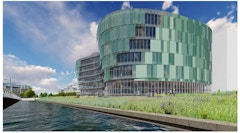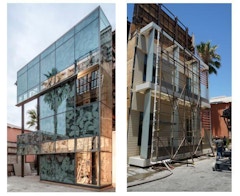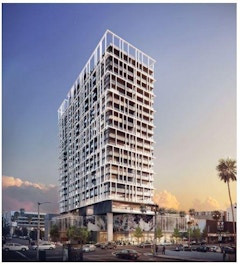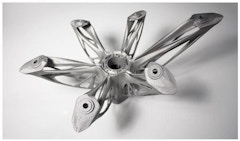
295 results
-
 A common building upgrade to add value to existing commercial real estate is the renewal of the entrance lobby. The lobby facade is replaced to give…
A common building upgrade to add value to existing commercial real estate is the renewal of the entrance lobby. The lobby facade is replaced to give… -

Deconstructing the Window
- Paper by Helen Sanders · Jörg Lenz · Petra Sommer
Over the years, the industry has relied heavily on the increasing performance of low-e coatings to drive window U-factors (thermal transmittance)
-

CR∆CKİNG THЄ CDЄ // DYN∆MİC L∆B F∆C∆DЄS
- Paper by Amanda King, AIA, LEED AP BD&C, CPHC · Dayita Kumar, LEED GA · Daniel Nauman, AIA, NCARB, LEED AP, CPHC
The real estate market continues to demand “all glass” buildings often to the detriment of human comfort and thermal performance. For an office
-

Envelope For Service
- Paper by Annalisa Andaloro · Miren Juaristi · Stefano Avesani · Giulia Santoro · Matteo Orlandi
Envelope-for-Service (E4S) is a novel business model developed with the aim of converting the building façade from a traditionally traded good to a
-

Finally
- Paper by Michael Mulhern
For over 60 years architects, engineers, and consultants have been specifying stainless steels for use in building skins and in some structural
-
Recent Adaptive Textile Façade Systems
- Paper by Lucio Blandini · Moon-Young Jeong · Michael Voigt · Jonathan Lopez · Hannah Schürmann · Arina Cazan · Hannah Raisch · Daniel Roth · Maria Matheou
Adaptive facade systems are a promising approach to achieve a dynamic response to varying weather conditions and user demands. The interdisciplinary
-

Structural Silicone Glazing
- Paper by Jon Kimberlain · Yvonne Diaz · Andrew Dunlap · Adrienne Bowman-Grittini
The recent 50 year anniversary of the first use of silicone sealant in a 4-sided structural silicone glazing application marks a sustainable and
-
DC Water Headquarters Case Study
- Paper by Sven Shockey · Leland Curtis · David Fersh
Facades must be responsive to a myriad of qualities and influences ranging from urban impact and aesthetic character to numerous performance
-

The Facade and Energy Codes
- Paper by Elliot Glassman
Ever-increasing performance requirements in the latest version of the energy codes are compelling project teams to consider the thermal performance
-
Transitions Between Diverse Envelope Systems
- Paper by Kristian Fosholt, LEED AP BD+C · Megan Koehler, AIA, LEED AP BD+C · Andrew Tsay Jacobs, AIA, EIT, LEED AP BD+C
The Lucile Packard Children’s Hospital at Stanford University in Palo Alto, California features an extremely diverse set of facade systems within one
-
Curved Forming Panel Facades
- Paper by Roger Schroeder
The performative and visual aspects of curved forming/bending thin “formable” planar materials is explored. Early tests for deflection indicate that
-
Advanced Simulation for Thermal Stress Assessment
- Paper by Andrea Zani · Jamie Reyes · Guido Lori · Jacob Hanke · Giacomo Zangiacomi
In recent years, the desire for increased performance, transparency and visual flatness of glazing elements in curtain walls has generated renewed
-
Integrated Energy Analysis
- Paper by Greg Verabian · Saurabh Shrestha · Laure Michelon
Energy codes across the country are progressively getting stricter and increasing the threshold for a baseline building’s energy performance.
-
Verifying Thermal Performance
- Paper by Matthew Herman · Mark Walsh
Architects specify curtain wall thermal performance criteria and usually identify simple modeling software, like THERM, to perform thermal analysis
-

Exo-Skins
- Paper by Nick Braaksma, Malini Srivastava, AIA, Chad Ulven,
Cost-effective, sustainable, self-actuating, thermally-responsive, bio-composite exo-skins that act like shields or cloaks for existing buildings… -

Novel Thermal Break Solution
- Paper by Yuzhen Steve Zhou
Thermal-break-blanket technology is a novel and high-performance thermal break solution for aluminum curtain walls. The thermal-break-blanket is
-

Climate-Oriented Prefabricated Building Envelopes
- Paper by Sridharan Gandhi, Andrew Tsay Jacobs, AIA, EIT, LEED AP BD+C, Karen Kensek, Assoc. AIA, LEED AP BD+C,
Facades developed in response to climactic factors increase performance and human comfort while reducing energy loads. A single building envelope… -
Differentiated Building Skin
- Paper by James Warton
The Los Angeles Stadium’s doubly curved skin is composed of over 35,000 unique triangular panels covering 296,502 square feet of surface area. The
-

Preserving a Historic Facade
- Paper by Maria Mohammed, S.E. · John Fidler, RIBA, Intl Assoc AIA, FRICS, FSA, FRSA, FIIC, FAPT
Environmental and socio-economic benefits of sustainable preservation have become apparent most recently in the restoration of the historic former
-
Facing Density
- Paper by Wendy Cox
The United Nations Department of Economic and Social Affairs projects a world population growth of over three billion over our current, nearly eight





